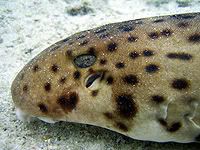
E: Environment, Enrichment,
Education, & Endangered Species
All content © by Diana L. Guerrero unless otherwise noted and may not be reprinted without prior written permission. All rights reserved. Click here for reprint permissions and fees.
The Epoaulette shark (Hemiscyillum freycineti) is our feature animal of the month. The Epoaulette shark is a small, slender-bodied bottom-dweller that uses its pectoral fins to "walk" across the seafloor. Not much is known yet as the discovery was just announced in September of 2006. Thanks to Conservation International for their assistance. We don't know it all...Conservation International researchers found a treasure trove of species at the Bird's Head Seascape in Indonesia.
Animal of the Month
Epoaulette Shark (Hemiscyillum freycineti )
Scientists recently surveyed two locations in a region known as the Bird's Head Seascape. The area proved to be a treasure trove yielding more than 50 new species, including sharks, shrimp, and reef-building corals.
The marine region is about the size of Missouri and serves as home to more than 1,200 species comprised of 200 types of reef fishes and nearly 600 species of hard corals, plus whales, sea turtles, crocodiles, giant clams, manta rays, and dugongs. The area may be Earth’s richest seascape.
Unlike the virgin wilderness of the nearby Foja Mountains, these reefs already show signs of human impact and are now coming under increasing threat from a proposed national policy to increase commercial fisheries in the region.
The sites, Cenderawasih Bay to the northeast and the FakFak-Kaimana coastline to the south, are located at two "corners" of the Bird's Head Seascape – named for the distinctive shape of the peninsula in northwest Indonesian Papua.
Mark Erdmann of Conservation International led the team of scientists on the expedition that began five years ago. In less than six weeks, they recorded a total of eight mantis shrimp species, 24 fish species, and 20 species of coral that are new or likely to be new to science. Many are believed to be endemic to the seascape, meaning that they are found nowhere else on Earth. Among the new species were two kinds of epaulette shark – small, slender-bodied bottom-dwellers that use their pectoral fins to "walk" across the seafloor.
Also discovered were several new species of "flasher" wrasses – named for the brilliantly colored displays the normally drab males flash to entice females to mate – along with fairy basslets, damselfishes, and a new jawfish. The scientists recorded a total of 1,233 species of coral reef fishes, at least 23 of them endemic.
Of more than 600 known species of coral in the region, nearly all were found within the team's survey sites. Six sites surveyed proved to have the highest diversity of hard corals ever recorded, each with more than 250 species within a single hectare.
"That's more than four times the number of coral species of the entire Caribbean Sea in an area roughly the size of two football fields," says Erdmann. "These reefs are literally 'species factories' that require special attention to protect them from unsustainable fisheries and other threats so they can continue to provide benefits to their local owners."
Threats to Area
While the coral reefs of the Bird's Head Seascape remain in relatively good shape, there is widespread evidence of bomb-fishing – a practice used to stun fish that are collected for food, or as bait for the lucrative shark fin industry. "On several survey dives, we heard reef-shattering explosions in the vicinity," says Erdmann.
Cyanide fishing is used to catch live lobster, grouper, and Napoleon wrasse for export to Asian live seafood markets, and this further threatens marine ecosystems in the area. Additionally, mining and logging in nearby coastal regions threaten to degrade water quality, possibly encouraging a population increase of the destructive crown of thorns starfish (Acanthaster planci) that leave a trail of dead coral in their path.
A plan to transfer fisheries pressure from Indonesia’s over-fished western seas eastward toward the Bird’s Head region may exacerbate there threats. While human population density is love in this area, the coastal people of Bird’s Head are heavily dependent on the sea for their livelihoods.
"The coastal villages we surveyed were mostly engaged in subsistence fishing, farming and gathering, and require healthy marine ecosystems to survive," explains Paulus Boli, a researcher from the State University of Papua, leader of the socioeconomic component of the expedition. "We are very concerned about the potential impact of planned commercial fisheries expansion in the region, and urge a precautionary approach that emphasizes sustainability over intensive exploitation."
About the columnist: Since 1978 Diana L. Guerrero has worked professionally with both wild and domestic animals. Guerrero has been affiliated with, and certified by, a variety of animal programs in the USA and Europe. Based in California, she writes, consults, and speaks. Information on her animal career programs, training courses, and her books {What Animals Can Teach Us about Spirituality (SkyLight Paths, 2003), Blessing of the Animals (Sterling, 2007), Help! My Pet is Driving Me Crazy (Guerrero Ink, 2007), Animal Disaster Preparedness for Pet Owners & Pet Professionals (Guerrero Ink, 2007)} can be found in this web site and in the shop. Questions for Guerrero should be submitted via the blog comments or membership forum.





